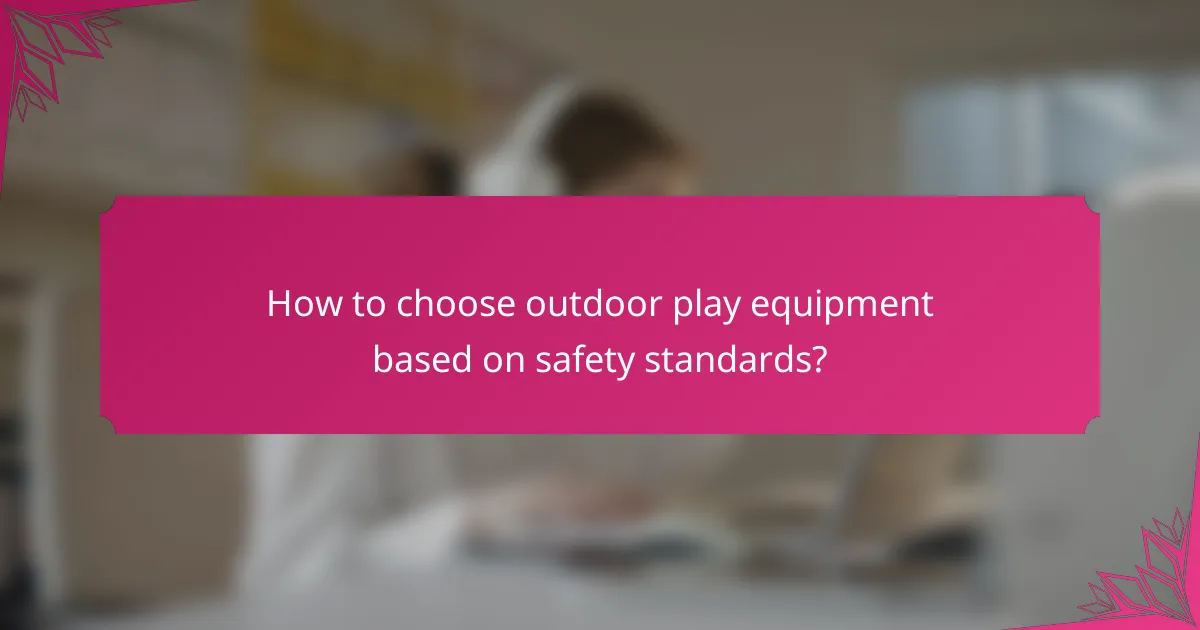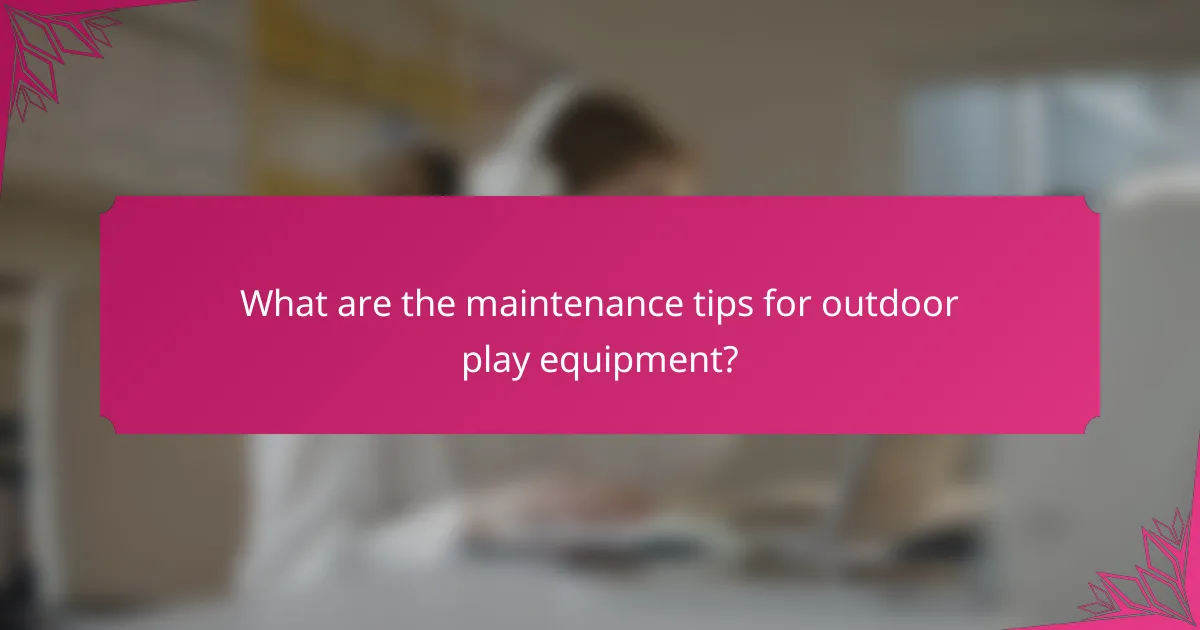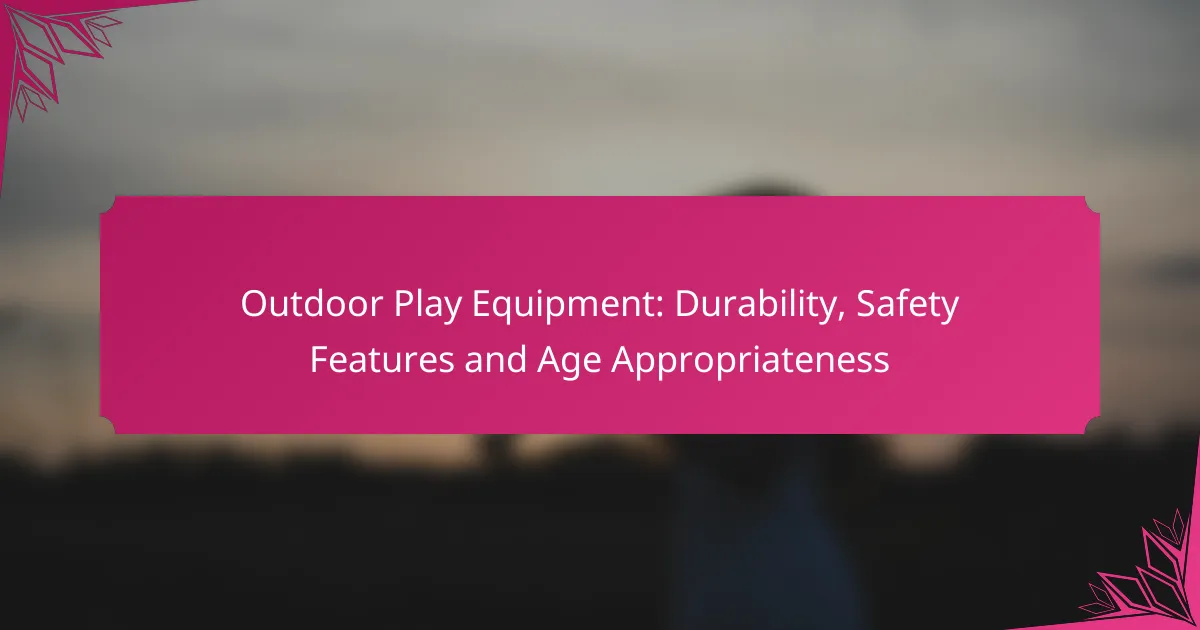When choosing outdoor play equipment, it’s essential to consider durability, safety features, and age appropriateness. Durable materials like wood, metal, and high-density plastic can enhance the longevity of playsets, while safety features are crucial for minimizing risks during play. Additionally, selecting equipment tailored to the specific age group ensures that children can enjoy safe and developmentally appropriate experiences outdoors.

What are the best outdoor play equipment options for durability?
The best outdoor play equipment options for durability include wooden playsets, metal climbing frames, composite material swings, high-density plastic slides, and weather-resistant coatings. Each type offers unique benefits and considerations that can enhance longevity and safety for outdoor play.
Wooden playsets
Wooden playsets are popular for their natural appearance and sturdiness. When selecting a wooden playset, look for options made from durable hardwoods like cedar or redwood, which resist rot and insects. Regular maintenance, such as sealing and staining, can extend the lifespan of these structures significantly.
Ensure that the wood is treated to meet safety standards, such as ASTM or CPSC guidelines, to prevent splinters and other hazards. A well-constructed wooden playset can last for many years, making it a worthwhile investment for families.
Metal climbing frames
Metal climbing frames are known for their strength and resistance to wear and tear. Typically made from galvanized steel or powder-coated aluminum, these frames can withstand harsh weather conditions. Look for frames that are rust-resistant and have rounded edges to enhance safety.
While metal frames can be more expensive upfront, their durability often results in lower long-term costs due to minimal maintenance. Ensure that the frame complies with local safety regulations to provide a secure climbing environment for children.
Composite material swings
Composite material swings combine the benefits of wood and plastic, offering durability without the maintenance needs of traditional wood. These swings are often made from recycled materials, making them an eco-friendly choice. They resist fading and splintering, providing a safe play experience.
When choosing composite swings, check for UV resistance and weight limits to ensure they can accommodate various ages and sizes. This type of swing can be a great addition to any outdoor play area, providing years of enjoyment.
High-density plastic slides
High-density plastic slides are lightweight yet robust, making them a popular choice for outdoor play equipment. They are resistant to cracking and fading, ensuring they remain safe and visually appealing over time. Look for slides that are designed to withstand extreme temperatures and heavy use.
These slides should meet safety standards and have smooth edges to prevent injuries. Installation on a soft surface, such as rubber mulch or grass, can further enhance safety and durability.
Weather-resistant coatings
Weather-resistant coatings are essential for extending the life of outdoor play equipment. These coatings protect against moisture, UV rays, and temperature fluctuations, which can degrade materials over time. Applying a quality sealant or paint can significantly enhance the durability of wooden and metal structures.
Regularly inspect and reapply coatings as needed, especially in regions with extreme weather. This proactive approach can help maintain the integrity and safety of outdoor play equipment for years to come.

How do safety features vary in outdoor play equipment?
Safety features in outdoor play equipment are designed to minimize risks and protect children during play. These features can vary significantly based on the type of equipment, intended age group, and manufacturer standards.
Impact-absorbing surfaces
Impact-absorbing surfaces are crucial for reducing injuries from falls. Common materials include rubber mulch, foam tiles, and engineered wood fiber, which can absorb shock and cushion landings. When selecting equipment, ensure the surface meets safety standards, such as those set by the American Society for Testing and Materials (ASTM).
For optimal safety, the depth of these surfaces should typically be at least 12 inches for equipment that is over 1 meter high. Regular maintenance is essential to keep these surfaces effective and safe.
Rounded edges and corners
Rounded edges and corners on play equipment help prevent cuts and bruises during play. Equipment designed for younger children often features more rounded designs to accommodate their developmental needs. Inspect equipment regularly to ensure that edges remain smooth and free from damage.
When purchasing new equipment, look for products that emphasize rounded designs, especially for toddler and preschool-age play areas.
Non-toxic materials
Non-toxic materials are essential for ensuring the safety of children who may put parts of the equipment in their mouths. Look for play equipment made from materials that are free from harmful chemicals, such as lead and phthalates. Manufacturers should provide certifications or labels indicating compliance with safety standards.
Choosing equipment made from natural wood or high-quality plastics can help ensure that it is safe for children. Always check for safety certifications like the Consumer Product Safety Commission (CPSC) guidelines.
Safety harnesses on swings
Safety harnesses on swings provide added security for younger children, preventing them from falling out during play. These harnesses can be particularly beneficial for toddlers who may not have the coordination to hold on tightly. Ensure that any swing set you choose includes adjustable harnesses that can grow with your child.
When using swings with harnesses, regularly check the straps for wear and tear, and make sure they are securely fastened before each use. This simple step can significantly reduce the risk of accidents.

What age-appropriate outdoor play equipment is available?
Outdoor play equipment varies significantly based on the age of the children using it. Selecting the right equipment ensures safety, promotes development, and provides enjoyable experiences tailored to different age groups.
Equipment for toddlers
For toddlers, outdoor play equipment should focus on safety and simplicity. Items like small slides, climbing frames, and sandbox sets are ideal, as they encourage exploration while minimizing risks. Look for equipment with rounded edges and non-toxic materials.
When choosing toddler equipment, ensure it is low to the ground and stable to prevent falls. Equipment should be designed for children aged 1 to 3 years, with a weight limit that accommodates their size.
Play structures for preschoolers
Preschoolers benefit from more complex play structures that encourage physical activity and social interaction. Climbing walls, multi-level playhouses, and swings designed for this age group promote coordination and imaginative play.
Choose structures that are built for children aged 3 to 5 years, ensuring they meet safety standards. Look for features like safety rails, soft landing zones, and age-appropriate heights to enhance safety during play.
Adventure sets for school-age children
Adventure sets for school-age children typically include larger climbing frames, zip lines, and obstacle courses. These structures cater to children aged 6 to 12 years, promoting physical fitness and teamwork through challenging activities.
When selecting adventure sets, consider the available space and the durability of materials. Ensure the equipment can withstand vigorous play and is anchored securely to prevent tipping. Regular maintenance checks are essential to keep the equipment safe and functional.

How to choose outdoor play equipment based on safety standards?
Choosing outdoor play equipment requires understanding safety standards that ensure durability and protection for children. Prioritize equipment that meets established guidelines to minimize risks and enhance playtime experiences.
ASTM International guidelines
ASTM International provides standards that focus on the safety and performance of playground equipment. These guidelines cover aspects such as materials, design, and installation, ensuring that equipment can withstand various weather conditions and heavy use.
For instance, ASTM F1487 outlines specifications for playground equipment aimed at children aged 2 to 12 years. This includes recommendations on surface materials to reduce fall injuries and design features that prevent entrapment hazards.
CPSC recommendations
The Consumer Product Safety Commission (CPSC) offers guidelines that complement ASTM standards, emphasizing safety in outdoor play areas. Their publication, “Public Playground Safety Handbook,” provides practical advice on equipment design, maintenance, and supervision.
Key recommendations include ensuring proper surfacing under and around equipment, maintaining clear zones free of obstacles, and regularly inspecting equipment for wear and tear. Following these guidelines can significantly reduce the risk of injuries during play.

What are the maintenance tips for outdoor play equipment?
To ensure outdoor play equipment remains safe and functional, regular maintenance is essential. This includes routine inspections, cleaning, and timely repairs to address any wear and tear.
Regular inspections
Conducting regular inspections is crucial for identifying potential hazards and ensuring the safety of outdoor play equipment. Check for loose bolts, rust, and any signs of damage that could compromise structural integrity.
Perform these inspections at least once a month, or more frequently if the equipment is heavily used. Look for issues such as splintered wood, cracked plastic, or worn-out safety mats that could pose risks to children.
Keep a checklist during inspections to track findings and repairs. This can include items like checking for proper anchoring, ensuring safety features are intact, and verifying that surfaces are clean and free from debris.
